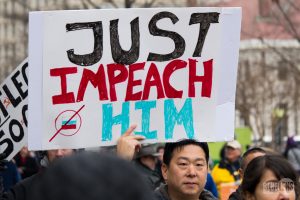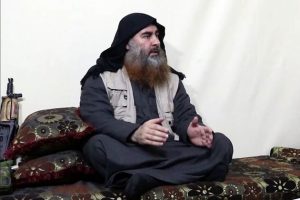by Wayne White
A Middle East Institute (MEI) study on Russia’s aims in Syria (much of which I wrote) predicted on November 10 what the Russo-Syrian-Iranian forces are doing right now: seeking to overrun most rebel holdings in the northernmost part of Syria. If this offensive succeeds, it would pose the greatest threat yet to Syria’s moderate rebels across the north. It could be a game-changer, leaving the rebels (and their Western and moderate regional backers) in a poor position to demand concessions in future talks.
Under a curtain of Russian air strikes, regime ground forces have been driving rebels from a swath of positions around and north of what is left of Syria’s once largest city Aleppo and elsewhere in Aleppo and Idlib Governorates. Pro-regime troops consist of Syrian Army regulars, thousands of Lebanese Hezbollah fighters, Iraqi Shi’a militiamen, and Russian advisors as well as Iranian advisors and combatants. Russia’s heavy-handed airstrikes (inflicting far more civilian casualties than the coalition’s) and the regime’s advances have driven over 100,000 more refugees to the Turkish border.
Syrian regime and Hezbollah combatants, like the rebels, have long been war-weary. Yet, against mostly lightly armed moderate rebels dogged by chronic shortages of ammunition, the forces aligned with Syrian President Bashar al-Assad were still formidable even when losing ground before Russia intervened in late 2015. Since then, regime forces have regrouped, are more heavily armed, and have been reinforced by Russian and Iranian advisors (along with Iranian proxy combatants). Moreover, Russian drone reconnaissance has made regime artillery far more accurate. So, early this year, their bolstered capabilities, coupled with vastly improved air support, finally began to reverse the ground game in their favor.
Worse still for the rebels, stemming the regime tide seems nearly impossible. Only considerable attrition among pro-regime ground forces in combat with the rebels could force their advances to slow or grind to a halt. This may happen at some point (as noted in the MEI study). However, if the Russians keep up the pace of air strikes (510 last week, says Moscow), such high attrition rates on the ground are unlikely to occur since many regime advances consist of occupying areas already blasted free of many rebels by Russian airstrikes. Indeed, not surprisingly, rebels in the Aleppo area say they are “simply being slaughtered” by the sheer weight of this firepower.
Meanwhile, Syrian Kurdish “People’s Defense Units” (or YPG) recently have drifted closer to Moscow. The YPG, so effective against the Islamic State (ISIS or IS) and therefore backed by the US, long maintained links to Damascus and could shift its alignment back to the regime if the military situation continues to tilt in favor of the regime in the north. In this context, the Russian delivery of arms to YPG fighters in one area north of Aleppo and Russian air support helping the YPG take an airbase near the Turkish border are ominous signs.
With this adverse situation on the ground as a backdrop, “peace talks” in Munich consisted of mainly US and Western pleas for the Russians to call a halt to hostilities to prevent further rebel losses, ease the miserable plight of refugees trying to flee across a veritable battlefield, and allow humanitarian relief to reach encircled rebel-held areas. The result is of dubious value.
On February 12, Moscow agreed to a “cessation of hostilities” on the ground (but not to begin for another week and not signed by the Syrians). Also, Russia was permitted to continue its air strikes so long as they are directed at IS and the al-Qaeda-affiliated al-Nusra Front. The Russians were given information on the positions of forces associated with both. Roughly 17 encircled areas (most held by rebels) have been designated for humanitarian relief.
In the air and on the ground, Russo-Syrian forces will now press hard to make additional gains this week, especially north of Aleppo toward the Turkish border in order to cut off the northern rebels from overland resupply. Also, since some moderate rebel combatants fight alongside al-Nusra against both regime and IS forces, even after the halt to most fighting the Russians will likely make an effort to knock out rebel forces anywhere near al-Nusra. Moreover, in an interview released on February 12, Assad declared ominously: “…if we negotiate, it does not mean that we stop fighting terrorism. The two tracks are inevitable in Syria.” Terrorism is standard Syrian code for all anti-government forces. Wary of claims that meaningful humanitarian resupply will be permitted to take place, relief organizations were rushing supplies into the Aleppo area by the one circuitous route still open as of February 13.
It seems astonishing, given Moscow’s confrontational posture elsewhere in the world such as Ukraine, that when Russia dove into the Syrian maelstrom last year Secretary Kerry thought it was a possible “opportunity” to join forces against IS. President Obama was more guarded in this comments. Probably still clinging to the hope that Russia would sign on to the US-led campaign against IS, Kerry declared in Moscow in December that the US and its coalition were “not seeking so-called regime change” in Syria (a major concession to Assad and his foreign allies). Yet, even after IS downed a Russian airliner over the Sinai in October 2015, Russian President Vladimir Putin only diverted air strikes against IS for less than a week before returning his focus to mainly US- and Western-backed rebel targets.
Defense Secretary Ashton Carter’s comment on February 12 that Russia is “way off track in Syria…throwing gasoline on an already dangerous fire” most likely will remain true for the foreseeable future. Putin seems determined, over time, to render as many rebels as possible west of IS unable to threaten the regime and to restore as much regime control as possible to what is known as “useful Syria” (the heavily populated and relatively well-watered western third of the country). Although in Munich all parties were asked “to contribute to an immediate reduction in violence”—even before the cessation in hostilities takes effect—the tempo of Russian air strikes has not fallen off substantially. Russian bombing reportedly destroyed two hospitals this week.
Ceasefires and humanitarian relief extended to rebels and rebel-held areas are likely to remain limited. They may temporarily polish the tarnished images of Putin and Assad as well as tempt rebels to quit the fight. But as Russian Prime Minister Dmitry Medvedev said on February 13: “We have slid back into a new Cold War.” Kerry, speaking of Syria and Ukraine, accused Russia of “repeated aggression.” The phone chat initiated by President Barack Obama with Putin over the weekend aside, Medvedev’s comments best capture Russian attitudes—and resultant misbehavior—that make trust in future Russian agreements like Munich misplaced.
Photo: Aleppo street scene






Monty says:
John I totally agree with you and hoping that the Russians don’t back off this time in Syria as they did in Afghanistan in 1980’s. The only good thing and the difference for Russia this time is the fact that Russians are beating the crap out of ISIS from the air and Hezbollah fighters with Iranian help are taking out ISIS on the ground one man at the time! The trio’s have a very good chance of becoming successful in their plan of attack and their support for Assad to regain control of his country one city and town at the time. Further more it is unlikely for the west to get involved in Syria again allowing Turkey, Saudi, Qatar, Jordan to get deeper in this quagmire! At least thru 2016 while Obama is the president.
An utter waste of time and a total insult to my intelligence. I wish the author would be kind enough and point out one moderate democracy loving rebel group anywhere in Syria or Saudi kingdom. They’re all terrorists you know it, so do we. Please no more empty propaganda.
Just a short follow up. While I understand it is not the policy of Lobelog for those commenting to include citations- e.g., to other journals- without including such, I would refer readers to an interview with V.P. Hasan, India’s former Ambassador to Syria (2009-2012) that appears in the most recent edition of the Swiss journal Current Concerns.
One is encouraged to read the interview of V. P. Haran, India’s former Ambassador to Syria (2009- 2012) in the most recent Common Currents. He not only addresses the U.S. role in destabilizing Syria, but also emphasizes that prior to the ‘uprising’, Syria was a country at peace with an economic growth rate of 5%, though with some dislocation of the population caused by a serious drought in the South. He also notes that Assad enjoyed strong political support in the country- of which our own State Department was fully aware- and noted in its internal communications- while exploring ways to destabilize the regime- something we later learned from the Wikileaks Syria disclosures. So, it makes no sense for State Department officials, past and present, to deny what the world now knows the Department knew and was discussing internally. I would also note that Assad and his government took in almost a million refugees during GW Bush’s Iraq War- feeding, housing and clothing them, and providing healthcare, as well as education for their children, under a social welfare system similar to what we used to aspire to, but have been steadily abandoning. None of this fits the image our Government and media (and NGOs) have been portraying.
The people don’t buy the hypothesis posed in this article. Regime change is US policy. Iraq, Libya, Honduras, Ukraine and Syria. As the Syrian situation falls out of the control of the US and the terrorists that are funded and armed by it’s NATO ally, it’s protectorate the KSA (to whom it sells the weapons that are distributed to the terrorists) they seek to blame Russia for the whole damn thing. The “alleged’ bombing of hospitals (no proof needed for the whole Western MSM to pin the blame on Russia) gets maximum publicity while the Turkish bombing of Northern Syria conveniently ignored. The 500 new terrorists recently sent to Northern Syria also ignored.
We know the game and the role of institutes such as The Middle East Institute. They lead and support US imperialistic policy.